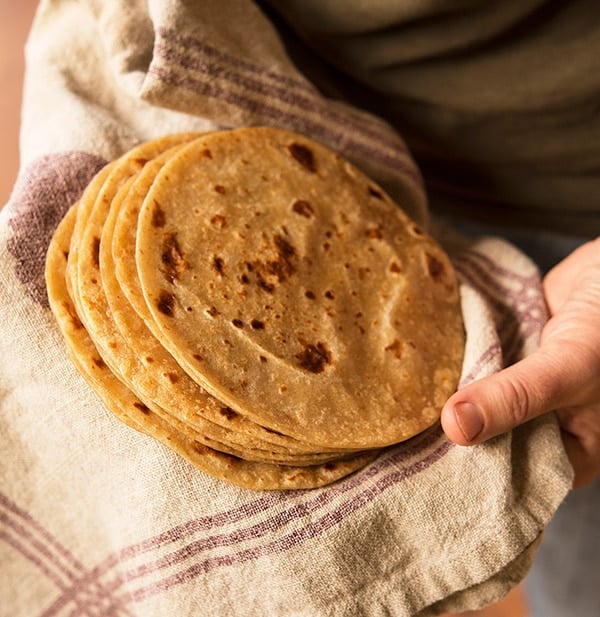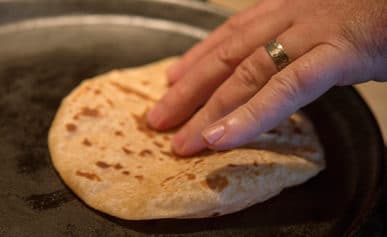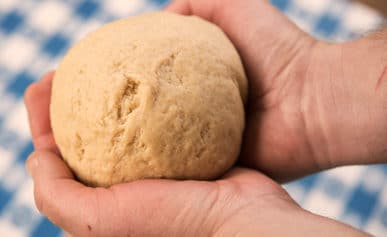As an Amazon Associate I earn from qualifying purchases.

Homemade flour tortillas are one of life’s greatest little pleasures. And they are surprisingly tricky to make. But, after much trial and error, I have come across a way to make perfect homemade flour tortillas.
I can’t tell you how happy I am to have nailed this recipe. I started with homemade corn tortillas, which are, actually, easier to make, believe it or not. Especially if you have really good masa harina, either from a place like Masienda or if you make homemade masa harina.
But homemade flour tortillas were another matter. My first attempts were basically Italian piadine, a very similar flatbread that, while tasty, is not a tortilla. Another attempt effectively made pita bread. Still not right.
One attempt added too much fat, and I made tortilla shortbreads. Another attempt seemed to be right, but broke when folded. Yet another puffed up so much they turned into balls.
And in every case, my homemade flour tortillas were ugly, misshapen, and most definitely not round. I watched countless YouTube videos on how to roll out flour tortillas, and I came to the conclusion that hand rolling a perfectly round flour tortilla is actually harder even than making handmade tortellini.

At a loss both mechanically and even for a recipe — there are many recipes for flour tortillas on the internet, and I’ve tried most. None were right — I turned to Spanish. Duh, right? But I am still not fluent in Spanish, so my reading comprehension isn’t perfect. But I started to slog through a series of books in Spanish that had recipes for tortillas de harina, or tortillas de trigo.
I also had an ace in the hole: My friend Patricio Wise, who runs the Mexican restaurant Nixtaco. Patricio is from Monterrey, where flour tortillas are a thing. His recipe, also developed from much trial and error, helped me a lot.
Incidentally, let me pause here for a moment to say that flour tortillas are every bit as Mexican as corn tortillas. OK? They’ve been made in that country for close to 500 years, not long after Cortes showed up from Spain in 1521. Flour has been part of the fabric of northern Mexico ever since.
In my opinion, the best flour tortillas are from Sonora, south of Arizona. They’re just my favorite, and you might prefer the slight variations you will see in Chihuahua, Nuevo Leon, Coahuila and yes, Texas. It’s all good. These here are Sonoran-style homemade flour tortillas.
What makes them Sonoran? A couple things. First and foremost, no baking powder. It simply isn’t needed. Make these tortillas correctly and they will puff up all by themselves.
Second, I use Sonoran flour, as well as a secret ingredient I’ll get to. First, Sonoran flour is different from regular all-purpose flour — although you can absolutely use regular AP if that’s all you have. (Here’s a cool little article on Sonoran flour tortillas.) It is softer than typical AP flour, which means that some of the soft wheat flours you get in the South, like White Lily, will also work.
Finally, here are my idiosyncratic additions: Smoked lard and a bit of roasted flour from the San Xavier Co-op south of Tucson. The wheat berries are roasted before they’re ground, which gives the flour an amazing aroma. It’s a whole wheat flour, so it darkens the tortilla. It’s basically impossible to find outside of Tucson, so skip it if you’re not a local there.
All homemade flour tortillas have fat. What fat is up to you. You can never go wrong with fresh lard, which is what I always use. It’s amazing stuff. Furthermore, I will smoke pork and then render the fat into lard, which, along with the smokiness of the roasted flour, makes the tortillas even more interesting. Bacon fat would be your easy substitute.
I’ve eaten flour tortillas cut with beef tallow, chicken schmaltz, vegetable shortening, butter and yes, vegetable oil. My recipe requires a solid fat, so lard or bacon fat should be your first two choices. They are also amazing with duck fat!
You need a scale to make this recipe correctly, as it largely hinges on weight. Your kitchen should have one, and if not, you can buy this nice one online.
Also, unless you are already an expert at rolling flour tortillas by hand, you need a tortilla press.
What?! You can’t make flour tortillas with a press! Yes you can. And here’s how.

Make the dough, then squeeze off the individual balls for the tortillas (more on that in a minute), then let them rest in a plastic bag for at least 1 hour, and as many as 6 hours. This long rest is vital. It allows the gluten in the tortillas to relax so you can squash them with the press without the tortilla springing back on itself.
I learned this method myself, through trial and error, but I knew I couldn’t be the only one who does it. And I was right. After I first posted this recipe some years ago, I heard from several people from Northern Mexico who do this, too. Great minds, eh?
A couple more tips: You don’t want your comal or flattop to be as hot as it needs to be with corn tortillas: 400°F to 450°F is fine. You flip homemade flour tortillas the same number of times as with corn, but flour tortillas cook faster.
I like tortillas about 30 to 35 grams per ball. That’s a nice size, more or less 6 inches across. Good for a taco, but go to about 40 to 45 grams for a quesadilla.
(Flour tortillas are a must for Sonoran arrachera tacos, made with skirt steak.)
Flour tortillas also keep better. Once made, these will keep for a couple days in the fridge, and will get supple again with only a short kiss of the comal.
I am so happy to share this recipe with you — it’s the product of many hours of work, and they taste amazing. Hope you like them!
Variations on Homemade Flour Tortillas
If you want to, you can substitute the roasted or whole-wheat flour portion of the dough with many other things to add interest or flavor. Some good, authentic choices would be acorn flour or mesquite flour
Any other sort of flour would also work here, too. And you will sometimes see maybe 1 or 2 tablespoons of small or ground seeds thrown in, too. The seeds of the barrel cactus or chia are sometimes used this way.
If you use a gluten-free flour like mesquite or acorn or whatever, don’t go much more than one-fifth by weight, so in the recipe below, 50 grams max in a batch of 250 grams’ worth of flour.
Homemade Flour Tortillas
Equipment
- Scale
- Tortilla press
- Comal or flattop or heavy frying pan
Ingredients
- 225 grams Sonoran, or all-purpose flour
- 25 grams Roasted or whole wheat flour (optional, see note below)
- 1/2 teaspoon salt
- 40 grams lard, bacon fat, duck fat, vegetable shortening or butter
- 7/8 cup hot water (see below)
Instructions
- Mix the two flours and the salt in a bowl. Add the lard and, using your fingers, work it into the flour until you have a texture similar to a coarse meal.
- Meanwhile, heat some water on the stove to a simmer. When it's hot, measure out a scant cup of water, about 7/8 of a cup, and add most of it to the flours. Mix well with a fork at first because it will be too hot to work with your hands. You want to see everything incorporated into a very pliable dough that is just short of being sticky. Sometimes it takes only 3/4 of a cup, sometimes a bit more. Never more than 1 cup of water, though.
- When the dough is cool enough to handle, knead it vigorously for 5 minutes. It should be a soft, pliable dough that is not sticky.
- Now, using your thumb and forefinger, squeeze off a ball of dough about the size of a walnut. Typically this is about 40 to 45 grams. You will eventually get all your balls within a few grams of each other without effort, but it takes practice. Squeezing off the balls keeps the gluten structure intact and makes for a better tortilla. Give each ball a roll to make it a ball and set it in a plastic bag. Do this with all the flour, re-kneading if you must. Set the balls to rest in the bag for 2 hours.
- Heat a comal or flattop to about 450F. Get your tortilla press out. If you don't already have them, you need two thin sheets of plastic to line it. I cut them from produce bags. You don't want thick plastic here. Take a dough ball out of the bag and re-roll it into a ball. Set it in the center of the press, then set the other sheet of plastic on it. Gently press it into a disc, then lever the top of the press down hard. Remove the plastic and set the flattened dough on your hand while you carefully remove the second piece of plastic.
- Carefully lay the tortilla on the comal and let it sit there until you see lots of little bubbles, about 30 to 45 seconds. Flip the tortilla, using a spatula if needed. Let this cook another 30 to 45 seconds, then flip one more time. By now the tortilla should have ballooned up in places. Move each finished tortilla to a tortilla warmer lined with paper towels, or set them in a kitchen towel, covered to steam and stay warm.
Notes
Nutrition
Nutrition information is automatically calculated, so should only be used as an approximation.












Have made this a dozen times already. Incredibly flexible recipe — have used it almost verbatim for dosas, too — and kid friendly. Perfect tortillas!
Hi Hank,
Glad I gave these a shot, the dough isn’t too hard to put together and squashing out little tortillas is surprisingly fun. One question I had regarding the cooking process, I am getting a lot of tortillas that are puffing up to one big bubble instead of lots of little bubbles after the first flip. Is this an issue of time or temperature on my part, or is the dough too wet? Given your remarks on pita bread in the introduction, I would assume that tortillas are NOT meant to puff so aggressively.
Hi Hank,
Really glad I gave these a shot, the dough is dead easy to put together and squashing out little tortillas is actually a lot of fun. One question regarding the cooking process, my tortillas seemed to balloon up very easily and even form one large bubble after flipping instead of many small bubbles. Does this indicate a problem with time or temperature on my part? Your mention of pita breads in the introduction has me suspect that tortillas are NOT supposed to puff up so aggressively.
Dan: Yep, that happens. You will want to lower the temperature a little. On my strong burner just past medium seems to be the sweet spot.
I’m Jewish so I avoid lard but I do have my turkey and chicken schmaltz and I’ll try it with trepidation. Thanks for the tips!
Miriam: They are AMAZING with schmaltz! Go for it.
I’m thinking about making some to use AS TP.
Of course I’ll be sure to make extra for eating with the wife’s famous Chile Verde!
Thanks- perfect timing! Since there are no tortillas of any kind in stores at this time (C-19 food shortages) we just happened to need a good tortilla recipe! Now, do you have one for bathroom tissue? ? Thank you!
Made these very successfully with Canadian cake and pastry flour, which has similar protein content to the Hayden Sonoran flour. This is my new go-to recipe for flour tortillas. I will make double next time.
Hi Hank, I’m planning on trying this out tomorrow. Given the times we find ourselves in, all the stores around me are sold out of AP flour, but I have a fairly strong bread flour. Do you think that will work, or will it be too tough?
Eric: Yes, it should work. But definitely be sure to rest the little dough balls for 2 hours in that case, to let the gluten rest.
Would it be detrimental to let the dough rest for longer than 6 hours? Say overnight?
Chris: I would not unless you refrigerated it.
Hank, thank you for this tested and true recipe! As a Tucson native living in an Asian city where the only flour tortilla option is Mission brand, full of preservatives and gummy/chewy, I am so excited to try these!
Do you think cake flour would be an acceptable substitute as a softer flour? Maybe a half/half mix with AP flour?
Cheers!
I just made these and they are delicious!! I had been trying to find the right flour tortilla recipe for my tortilla press for weeks and this recipe did the trick. I think the hot water and the fat/flour proportions made all the difference.
What do you think of using beef or venison tallow, I have a bunch of both?
Marion: Beef fat is used in Mexico, but I would not use venison fat. Too waxy.
Hey Hank , Do you have a recipe for corn tortillas?
Wife is gluten free and wanted to see how I can get a good tasty and authentic corn tortilla!!!
Thanks
Tom
Thomas: Yes, I do. Here it is: https://honest-food.net/how-to-make-corn-tortillas/
Hi Hank,
I very much look forward to making your tortillas. Like you, I’ve made just about every version and so far I’ve only come up with moderately acceptable tortillas. Meh. I admire your persistence, I’m the same that way. Shrimp tacos in these tortillas tonight. 🙂
Anita Street Market in Tucson has the best flour tortillas I’ve ever had (I’ve usually got a few dozen in the freezer–I bring them back from Tucson, but they will ship). Their gorditas (small sized tortillas–not thick like some gorditas) have some requeson (similar to ricotta and available fresh at Latino markets) in them which makes them richer tasting and a little sweet. Patricio at Nixtaco told me he sometimes uses whey from making cheese instead of water when making his flour tortillas. All good things to try!
Dane: I’ve heard of the whey trick, too. Need to give it a go.
I use pizza dough that I always have in fridge.Dryfry on high,then pass it directly on gas flame on medium high,Then I split and bake in toast oven until crisp like crakers.
Incidentally, let me pause here for a moment to say that flour tortillas are every bit as Mexican as corn tortillas. OK? They’ve been made in that country for close to 500 years, not long after Cortes showed up from Spain in 1521. Flour has been part of the fabric of northern Mexico ever since.
Excellent point. Time and again, in making a comparison between Tex-Mex and Mexican food, articles state that corn tortillas are Mexican, while flour tortillas are Tex-Mex. As with much of Tex-Mex food, flour tortillas are both Texan/Tejano and Northern Mexico/Norteño.
The Northern Mexico-Texas interchange works both ways. Obviously, Tex-Mex flour tortillas came from Northern Mexico. For some music, influence has gone from Texas to Northern Mexico.
Tejanos adopted – dare we say appropriated? – the accordion and polkas of the 19th century German and Czech immigrants to Texas. Flaco Jimenez – En Vivo (1976) The polkas and accordion of Tejano music found their way south, to Northern Mexico. Norteño music makes ample use of accordions or polkas. Here, it uses both.Ramón Ayala Y Sus Bravos Del Norte – Stocky (Polka).
Adding mesquite flour makes for an interesting and tasty tortilla.
Can I try roasting some flour on a cast iron or carbon steel skillet? I have no access to ether flour in Finland…
Federico: Yes, you can, but be careful that it only browns, not blackens.
Roasting wheat berries is an intriguing idea. I’ve been making a lot of fresh pasta with home-milled spelt (sometimes with egg and sometimes with water alone.) How do you think this would work in pasta? How would you sauce it? Can I assume roasting the berries in an iron skillet, like spices, would be sufficient?
Thanks
Jay: It works very well in pasta. I did this for pasta a decade or more ago, and I love it when you want a darker, smokier pasta with your sauce.
Gonna have to give it a try to make flour tortillas from scratch. I usually buy the “Del Comal” uncooked packaged flour tortillas and they are usually purty bueno. But the best tortillas were made by my grandma, using lard. Oh man where they good, like hurt yourself cause you polished off 1/2 a dozen with melted butter good! Thanks for the recipe!